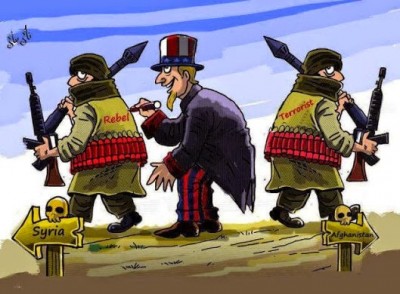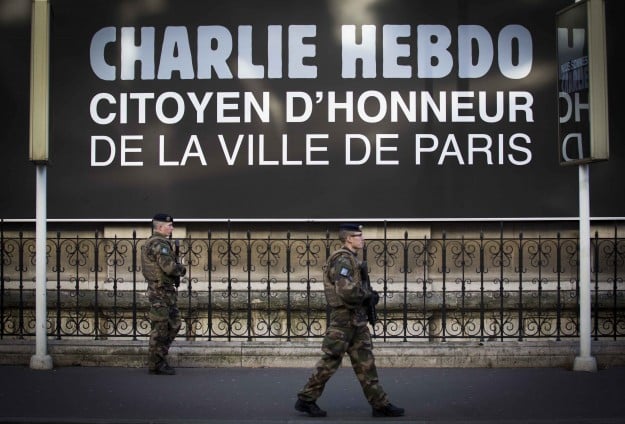Beware the Children: The Young Terrorists are Here!

If they are not coming to a military parade near you, vomiting ideological pile at a police station, or some such edifice of authority, they are certainly planning to, endorsing some idea of it, or demonstrating a keenness on sneaking a head off here and there. Welcome to the world of terrorist toddlers, pubescent teens, and youngsters.
Australia’s foreign minister, Julie Bishop, certainly thinks so. In a session chairing the UN Security Council last year, she told members how, “Terrorists are younger, more violent, more innovative and highly interconnected.” Instead of numbing themselves with the dreary effects of social media, they have used it enterprisingly “to terrorise, and to recruit, and are very tech-savvy.”[1]
And there is no better time to be a terrorist in whatever shape and form than now. Dr. Clarke Jones from the Australian National University is convinced, gazing into some rather cloudy crystal ball, that 2015 “is going to be a year of terrorism in the sense that I think we are going to see more small scale attacks.” Apparently, terrorism, in its “nature,” is changing.
Obviously Jones is unburdened by the weight of violent nationalist movements that littered Europe in the nineteenth century, and the post-colonial world in the twentieth, with its various victims of terrorism. We are so modern, and so different.
These young demons, for Bishop, seemingly shelter behind the veil of prosaic behaviour – such as then 17-year-old Adam Dahman, “who grew up in a typical Australian household and played sport for his local high school.” Or the three Succarieh brothers from Brisbane.
In Britain, excitement abounds over the issue of a 14-year-old, said to be the remarkable mastermind of incitement of Australian teenagers arrested in connection with a supposed terrorist plot against recent Anzac commemorations. The teenager in question has been charged with two offences of inciting terrorism overseas in communicating with the young Melbourne-based Sevdet Besim “namely to carry out an attack at an Anzac parade in Australia with the aim of killing and/or causing serious injury to people.” Presumption, it would seem, is sufficient to constitute a credible threat.
The prosecutors have certainly been doing the rounds nabbing the garrulous young, taking note of language that sounds like the puerile antics of shopping mall video gaming. (The words uttered via the encrypted message on Telegram were an encouragement that Besim “sharpen his knife as hard as he could.”) The teenager was initially arrested with a 16-year-old girl from Manchester on April 2. They subsequently received bail after being questioned on suspicions of preparing a terrorist act. Evidently not satisfied, the authorities re-arrested the 14-year-old on April 18.
According to Deborah Walsh, the deputy head of counter terrorism at the UK Crown Prosecution Service, the incitement took the form of encouraging a beheading in Australia during the course of Anzac Day celebrations involving a knife, then a gun or a “car-up” on police. The beheading of a “loner” was to be the appetiser, allowing the audience to “get a taste for it”.
In Walsh’s words, “The decision to prosecute has been taken in accordance with the Code for Crown Prosecutors. We have determined that there is sufficient evidence or a realistic prospect for conviction and that a prosecution was in the public interest.” Realism, evidently, is in the eye of the prosecutorial beholder.
Why the fuss? The enthusiastic authorities cite converts to the ISIS cause, noting, for instance, groups of young women as young as 15 who have travelled to join the group in Syria last year. (The mistake here is to draw the next conclusion: that these girls are the next bomb throwers and conscientious executioners.) The number, noted in The Independent (May 1) totals about 22. Prominent has been the case of London trio Shamima Begum (15), Kadiza Sultana (16) and Amira Abase (15). Everywhere, there are fears of a fifth column of radicalised returnees and blood-savage recruits.
This orgiastic fearfulness has made those in power worried. They are starting to see terrorists everywhere, from pram to pulpit, from diaper to primary school. To date, the French authorities have come closest in astonishing law watchers with their interest in the phenomenon of terrorist children. On January 8, a day after two gunmen attacked the offices of the satirical magazine Charlie Hebdo, an eight-year old boy reported as Ahmed was asked in his primary school class in Nice whether he was “Charlie”. Taking issue with the question, he suggested that, “I am on the side of the terrorists, because I am against the caricatures of the prophet”.
The stunned teacher conveyed the youngster to the principal, who then reiterated the question three more times in front of the class in collective chiding. “Are you Charlie?” The incident was subsequently reported by the administrators to the police, who went about their diligent task protecting the French Republic against the purported silliness of a child of eight who had not provided suitable homage for the moment by interrogating him.
According to Fabienne Lewandowski of the Alpes-Maritimes regional police, the school principal insisted that the child had suggested “French people should be killed,” “I am on the side of the terrorists” and “the journalists deserved to die.” Sefen Guez Guez, the lawyer representing Ahmed, could only conclude that the police, in questioning his client, showed how France had succumbed to a “collective hysteria”.[2]
What has changed in this latest round of authoritarian lunacy is not the type of terrorism, but the response of authorities to perceptions of what form it might take. The weight attributed to such terms as incitement has diminished to that of a feather. The delusionary ranting of a child is taken as the ideological promise of a fully-fledged fanatic able to massacre and maim. Those defending the law should far more questioning of such premises.
Dr. Binoy Kampmark was a Commonwealth Scholar at Selwyn College, Cambridge. He lectures at RMIT University, Melbourne. Email: [email protected]
Notes:
[1] http://www.theaustralian.com.
[2] http://electronicintifada.net/


